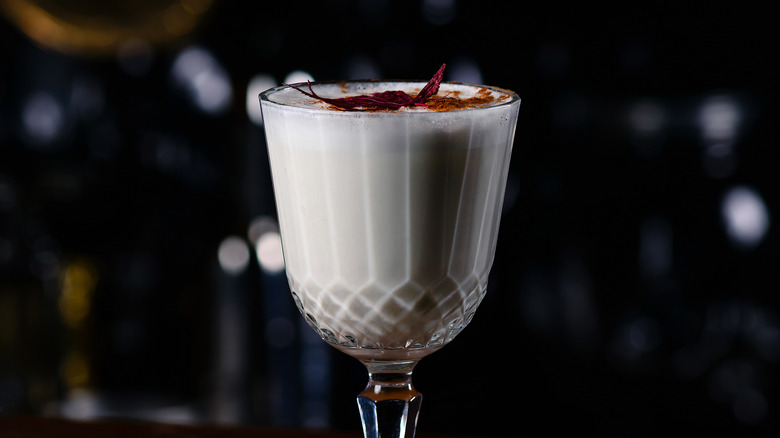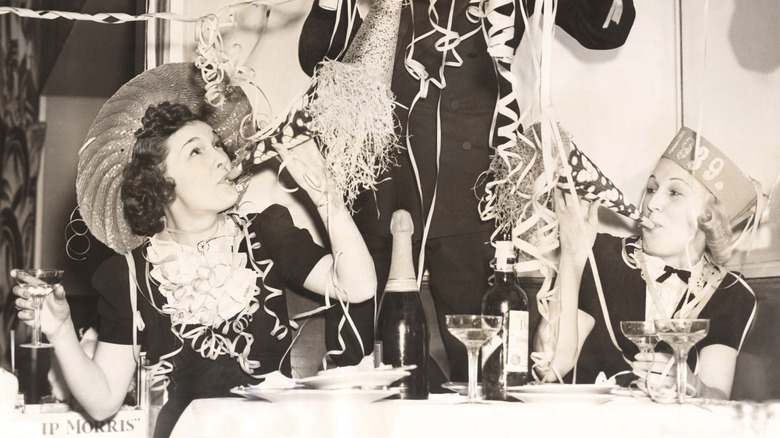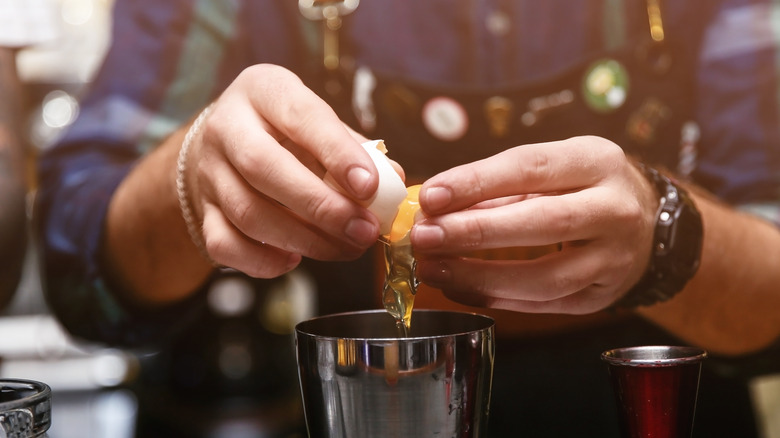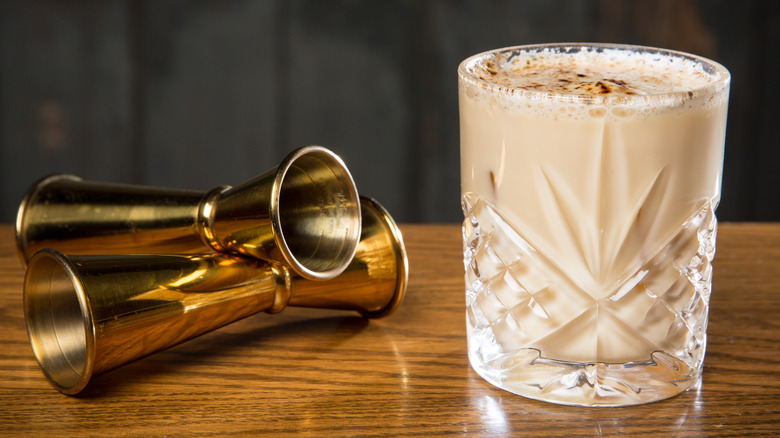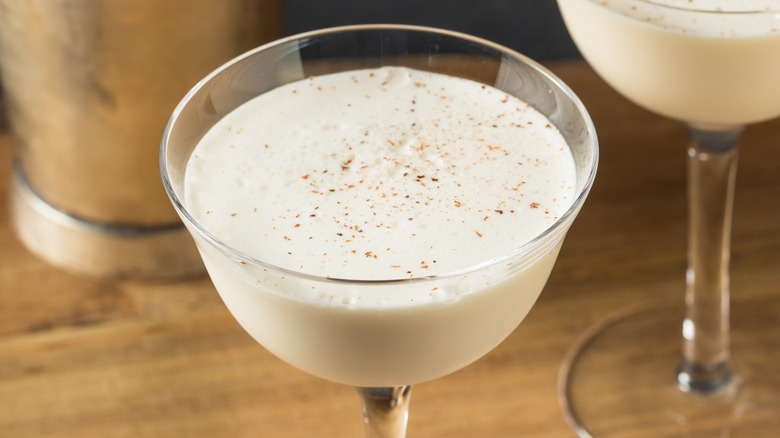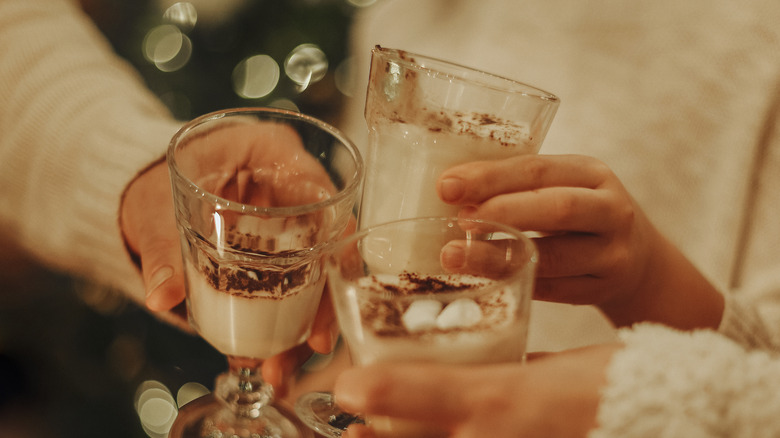Each Branch Of Canada's Military Stakes Claim In The Moose Milk Cocktail
In the United States, the military is a big deal. Since the end of World War II, the American military has been generously funded and expanded. Current active-duty personnel number 1.3 million, making the United States Armed Forces the largest voluntary service military in the world. Americans celebrate all aspects of our military across multiple holidays throughout the year, being sure to always keep those who serve close to our hearts and minds. Up in Canada, however, things are a little different.
Canada certainly has a proud military tradition, but the present standing army is not nearly as large or as well-funded as the U.S. Canada has fewer than 100,000 in active military. Still, gratitude for those serving is just as high in Canada as it is in the States. And while things are done on a much smaller scale, the military remains an important aspect of Canadian life.
While Canada's Armed Forces have their fair share of official customs and traditions, including music, flag waving, and how to properly send off a ship, there is a friendly rivalry between the branches that centers around the origins of a specific cocktail called moose milk. No, it is not actually made with the milk of the enormous forest-dwelling creature so symbolic of the Great White North, but it's about as Canadian a cocktail as you're likely to find.
A (debated) origin of moose milk
While there is no clear beginning to the moose milk cocktail phenomenon, the most repeated story centers around a New Year's Eve party at an armed forces base in Ontario sometime during World War II. As Canadian winters tend to be on the colder side, a potent, filling concoction was needed to warm the bodies and spirits of the serving troops. As the story goes, a young flight sergeant was tasked with creating a punch strong enough to satisfy the troops but flavorful enough for the party's female attendees to enjoy. The result was called moose milk, a particularly boozy rendition of an eggnog punch.
The notion of enjoying a hearty beverage on New Year's Eve is hardly new to Canadians. Indeed, the tradition that spurred the creation of the moose milk cocktail dates back several hundred years. Levée is a New Year's tradition in Canada that began in the 17th century as a way of gathering settlers, village leaders, and dignitaries together to be greeted by a royally appointed colonial Governor. The tradition continues to be a shrewd governmental PR tactic.
For members of the military, Levée attendance was mandatory as the Armed Services need to act in accordance with the Crown. Today, the military still holds Levée parties on New Year's Eve as a way of greeting both military and civilian guests with a spirit of conviviality by opening up the mess hall, serving cocktails, and firing salutes.
Moose milking basics
Each branch of the Canadian military claims to have been the one to have invented the moose milk cocktail, which is why a formal recipe for one is so difficult to pin down. The Army, Navy, and Royal Canadian Air Force (RCAF) each lay claim to the cocktail as their own, and their recipes are as varied as the services they provide for the nation.
Retired major Michael Boire referred to moose milk as "high-propulsion eggnog" when talking to Imbibe Magazine. The idea behind the cocktail is that it is so loaded with booze and sweets that the effect on the drinker is something akin to burning jet fuel. Eggnog originated in medieval Britain and quickly became associated with Yeultide wishes of good health, prosperity, and merriment. A simple combination of egg yolks, milk, sugar, and some kind of alcohol, eggnog traveled with the British to the North American colonies, where it naturally engrained itself amongst the farming colonists. It's this traditional winter drink, the central core of the moose milk cocktail, providing it with its indicative creamy color and frothy texture.
While eggnog sits at the core of the cocktail, it remains, essentially, a catch-all concoction of whatever happens to be laying around base or home. Such is the case with the Army and Navy recipes.
Army and Navy moose milk
Now, as we've said, each branch of the Canadian military has its own unique variation on the moose milk cocktail. As the drink has come to be most commonly associated with the Navy, we'll use its foundational recipe as an example of just how crazy this cocktail can be.
The recipe for Canadian Navy moose milk is as follows: a gallon of vanilla ice cream, a pot of cold coffee, half a gallon of milk, one pint each vodka, dark rum, and Kalhúa, and, finally, an unspecified amount of dark chocolate. If, upon reading this recipe, you're already starting to feel tipsy, remember that these proportions are intended to satisfy whole units of sailors, who already have an affinity for drinking, owing to the historical fact that alcohol was once safer to drink than water and barrels of beer were frequent cargo on naval vessels.
Lest you think sailors are the only ones mixing up jet fuel, the Army has its own version that keeps all the booze, swaps out the milk for eggnog, adds maple syrup, vanilla extract, and 20 ounces of Disaronno, and omits the dark chocolate. Both Navy and Army pour the ingredients into a blender or large pot and mix until frothy, cool liquid forms. This is not the most hands-on moose milk. They omit the egg yolks and, therefore, the necessity to beat them into an eggnog. The RCAF, however, takes a much more methodical approach.
RCAF moose milk
The Royal Canadian Air Force, likely owing to the precision and engineering prowess it takes to fly a warplane, takes a more hands-on, time-consuming approach to their moose milk recipe. While the Army is perfectly content to splash gallon after gallon of store-bought eggnog into their moose milk, the RCAF recipe appears to take the extra step and actually go about making the nog base from scratch.
Starting with 12 egg yolks, the yolks are beaten together with sugar, milk, maple syrup, Canadian whisky, rum, and Kalhúa and set to chill in the fridge for a minimum of three hours or up to overnight. Whipped cream is then gently folded into the mixture, which is returned to the fridge to cool for another hour. The whipped cream needs to be mixed every so often so that it doesn't separate from the main mixture.
At this point, any service member hoping for a quick drink would be chomping at the bits for a taste of RCAF moose milk, but the recipe has a finishing flourish. After it's served up into a chilled glass, the cocktail can be sprinkled with nutmeg or cinnamon or both, whatever the drinker fancies. Then the stuff disappears faster than a Mach 5 jet splitting the hypersonic barrier. Such is the life of a batch of moose milk.
Endless variety
There is a more than fair chance that a Canadian veteran or active duty serviceman will read this article and exclaim: "Those recipes aren't the right way to make moose milk!" And they would be correct, in a way. Think of moose milk the way you would think of a cheeseburger. Everyone has their own preferred way of making one, and that way is the undisputed "right way" to do it. Civilian versions of moose milk are often a little richer but no less strong than the military versions. Additions like condensed milk, coffee, and various alcohols make for an endless variety of recipes.
The fact that this cocktail has attained such legendary status in such a relatively short period of time may make it so that, when future historians look back on the Levées of our present time, moose milk will be as mandatory as attendance once was in the 17th century. It already is required, in a way, as even the government admits that it's not a New Year's Levée without several helpings of moose milk to ring in the new year.
And that's the beauty of moose milk. It can be anything you want it to be as long as it follows the same basic principles: mix a lot of booze together with a lot of sweets and some eggnog, and PRESTO! You're drinking moose milk. And after a glass or two, you'll probably feel like you've been hit by one.
